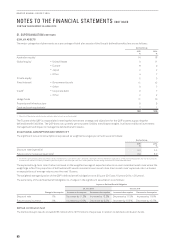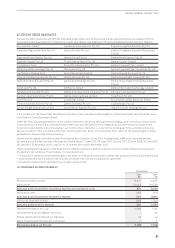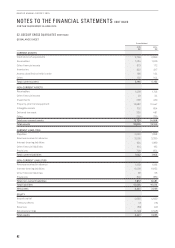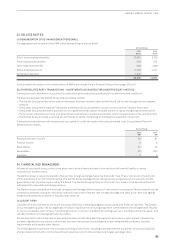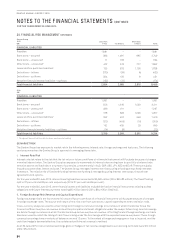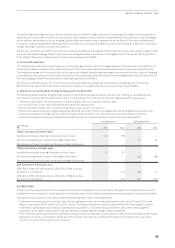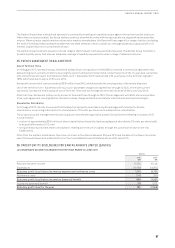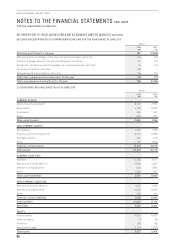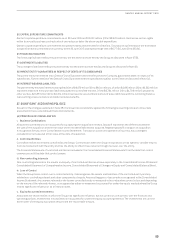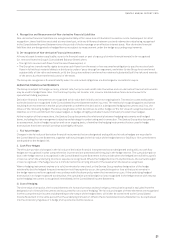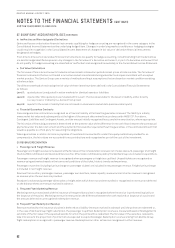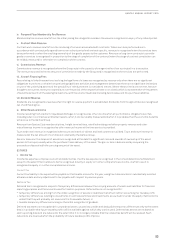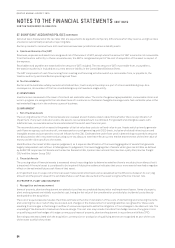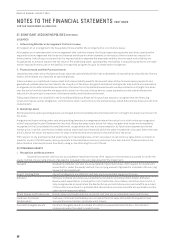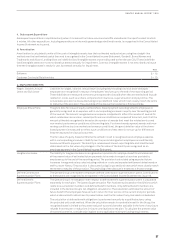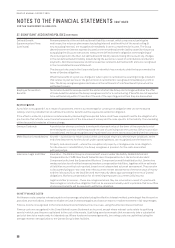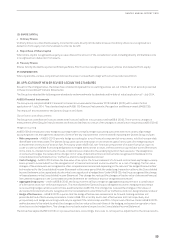Qantas 2015 Annual Report Download - page 91
Download and view the complete annual report
Please find page 91 of the 2015 Qantas annual report below. You can navigate through the pages in the report by either clicking on the pages listed below, or by using the keyword search tool below to find specific information within the annual report.
NOTES TO THE FINANCIAL STATEMENTS CONTINUED
FOR THE YEAR ENDED 30 JUNE 2015
90
QANTAS ANNUAL REPORT 2015
37. SIGNIFICANT ACCOUNTING POLICIES CONTINUED
The Group’s share of the associates’ post-acquisition profit or loss is recognised in the Consolidated Income Statement from the
date that significant influence commences until the date that significant influence ceases. The Group’s share of post-acquisition
movements in reserves is recognised in other comprehensive income. The cumulative post-acquisition movements are adjusted
against the carrying value of the investment.
Dividends reduce the carrying amount of the equity accounted investment.
When the Group’s share of losses exceeds the equity accounted carrying value of an associate, the Group’s carrying amount is
reduced to nil and recognition of further losses is discontinued, except to the extent that the Group has incurred legal or constructive
obligations to fund the associates’ operations or has made payments on behalf of an associate.
vi. ransactions Eliminated on Consolidation
Intra-group transactions, balances and unrealised gains and losses on transactions between controlled entities are eliminated
in preparing the Consolidated Financial Statements. Unrealised gains and losses arising from transactions with investments
accounted for under the equity method are eliminated to the extent of the Group’s interest in the associate.
(B) FOREIGN CURRENCY
i. Foreign Currency Transactions
Transactions in foreign currencies are translated to the functional currency of the Group at the rates of exchange prevailing at the
date of each transaction except where hedge accounting is applied. At reporting date, monetary assets and liabilities denominated
in foreign currencies are translated to the functional currency at the rates of exchange prevailing at that date. Resulting exchange
differences are brought to account as exchange gains or losses in the Consolidated Income Statement in the year in which the
exchange rates change. Non-monetary assets and liabilities that are measured in terms of historical cost in a foreign currency
are translated using the exchange rate at the date of the transaction. Non-monetary assets and liabilities denominated in foreign
currencies that are stated at fair value are translated to the functional currency at foreign exchange rates prevailing at the dates the
fair value was determined.
ii. Foreign Operations
Assets and liabilities of foreign operations, including controlled entities and investments accounted for under the equity method,
are translated to the functional currency of the Group at the rates of exchange prevailing at balance date. The income statements of
foreign operations are translated to the functional currency at rates approximating the foreign exchange rates prevailing at the dates
of the transactions. Exchange differences arising on translation are recognised in other comprehensive income and are presented
within equity in the foreign currency translation reserve. When a foreign operation is disposed of such that control, significant
influence or joint control is lost, the cumulative amount in the translation reserve related to that foreign operation is reclassified to
the Consolidated Income Statement as part of the gain or loss on disposal. When the Group disposes of only part of its interest in
an investment accounted for under the equity method that includes a foreign operation, while retaining significant influence or joint
control, the relevant proportion of the cumulative amount is reclassified to the Consolidated Income Statement.
When the settlement of a monetary item receivable from or payable to a foreign operation is neither planned nor likely in the
foreseeable future, foreign exchange gains and losses arising from such a monetary item are considered to form part of the net
investment in a foreign operation and are recognised in other comprehensive income and are presented within equity in the foreign
currency translation reserve.
(C) FINANCIAL INSTRUMENTS
NON-DERIVATIVE FINANCIAL INSTRUMENTS
i. Recognition and Measurement of Non-derivative Financial Assets
The Group classifies non-derivative financial assets at initial recognition as either financial assets at fair value through profit and
loss or financial assets at amortised cost.
Financial assets at fair
value through profit
or loss
A financial asset is classified as at fair value through profit or loss if it is classified as held-for-trading
or is designated as such on initial recognition. Directly attributable transaction costs are recognised
in profit or loss as incurred. Financial assets at fair value through profit or loss are measured at fair
value and changes therein, including any interest or dividend income, are recognised in profit or loss.
Financial assets at
amortised cost
These assets are initially recognised at fair value plus any directly attributable transaction costs,
except for trade receivables which do not contain a significant financing component and are
recognised at transaction price. Subsequent to initial measurement, they are measured at amortised
cost using the effective interest rate method.


